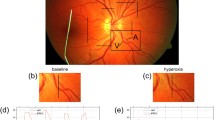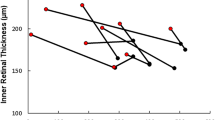Abstract
•Background: Therapeutic isovolemic hemodilution has been reported to improve blood flow and oxygen delivery. Few reliable measurements have been made, however, showing the effect of hemodilution on tissue oxygen tension.
• Methods: We measured retinal oxygen tension during experimental isovolemic hemodilution in normal cats. Polarographic oxygen microelectrodes were placed in the vitreous humor within 100–200 μm of the retinal surface.
•Results: Tissue oxygen tension increased initially during isovolemic hemodilution to a maximum approximately 50% above baseline at approximately two thirds of the original hematocrit level. Hemodilution beyond this point to lower hematocrits caused a steady decline in tissue oxygen tension. Cardiac output measured in one cat undergoing isovolemic hemodilution increased as hematocrit was lowered, but the cardiac erythrocyte flux actually decreased steadily.
•Conclusion: The observed increase in tissue oxygen tension with hemodilution appears to be explained by a lesser reduction in capillary than in systemic hematocrit, coupled with an increased capillary blood flow. The increase in tissue oxygen tension we observed could in part explain the clinically beneficial effects of hemodilution.
Similar content being viewed by others
References
Alder VA, Cringle SJ (1985) The effect of the retinal circulation on vitreal oxygen tension. Curr Eye Res 4: 121–129
Bates ML, Feingold A, Gold MI (1975) The effects of anesthetics on an in-vivo oxygen electrode. Am J Clin Pathol 64: 448–451
Braun RD, Linsenmeier RA, Goldstick TK (1992) New perfluorocarbon emulsion improves tissue oxygenation in cat retina. J Appl Physiol 72: 1960–1968
Brueckner UB, Kefalianakis F, Krieter H, Messmer K (1993) Organ blood supply and tissue oxygenation after limited normovolemic hemodilution with 3% versus 6% Dextran-60. Infusionsther Transfusionsmed 20: 130–139
Dedichen H, Schenk WG (1967) Hemodilution and concomitant hyperbaric oxygenation. J Thorac Cardiovase Surg 53: 341–348
Desjardins C, Duling BR (1987) Microvessel hematocrit measurement and implications for capillary oxygen transport. Am J Physiol 252: H494-H503
Ernest JT (1980) Blood flow in normal and abnormal retinal vessels. Trans Ophthalmol Soc UK 100: 343–345
Ernest JT (1988) Regulatory mechanisms of the retinal vasculature in health and disease. In: Tso MOM (ed) Retinal diseases. Lippincott, Philadelphia, pp 131–137
Ernest JT, Goldstick TK, Engerman RL (1983) Hyperglycemia impairs retinal oxygen autoregulation in normal and diabetic dogs. Invest Ophthalmol Vis Sci 24: 985–989
Hansen LL, Danisevskis P, Arntz H, Hoverter G, Wiederholt M (1985) A randomized prospective study on treatment of central retinal vein occlusion by isovolaemic haemodilution and photocoagulation. Br J Ophthmol 69: 108–116
Hansen LL, Wiek J, Wiederholt M (1989) A randomized prospective study of treatment of non-ischemic central retinal vein occlusion by isovolaemic haemodilution. Br J Ophthalmol 73: 895–899
Heinrich RN, Machac N, Gunderoth-Palmowski M, Dette S (1988) Influence of normovolemic hemodilution with 10% IIES 200 on tissue PO2 in the m tibialis ant of 7 male volunteers. In: Mochizuki M, Honig CR, Koyama T, Goldstick TK, Bruley DF (eds) Oxygen transport to tissue X. Proceedings of the 15th Annual Meeting of the International Society on Oxygen Transport to Tissue held in Sapporo, Japan, 22–24 July 1987. Plenum Press, New York, pp 615–622
Kohner EM, Barnes AJ, Hill DW, Young S, Reid HL, Dormandy JA (1979) The effect of viscosity on retinal blood flow. I. Effects of isovolumetric haemodilution. In: Shimizu K, Oosterhuis JA (eds) Ophthalmology: Proceedings of the XXIII International Congress, Kyoto, 14–20 May 1978. Excerpta Medica, Amsterdam, pp 826–829
Kuo L, Pittman RN (1988) Effect of hemodilution on oxygen transport in arteriolar networks on hamster striated muscle. Am J Physiol 254: H331-H339
Laks H, O'Connor NE, Pilon RN, Anderson W, MacCallum JR, Klovekorn WP, Moore FD (1973) Acute normovolemic hemodilution: effects on hemodynamics, oxygen transport, and lung water in anesthetized man. Surg Forum 24: 201–202
Linsenmeier RA, Goldstick TK, Blum RS, Enroth-Cugell C (1981) Estimation of retinal oxygen transients from measurements made in the vitreous humor. Exp Eye Res 32: 369–379
Lipowsky HH, Firell JC (1986) Microvascular hemodynamics during systemic hemodilution and hemoconcentration. Am J Physiol 250: H908-H922
McHugh RD, Epstein RM, Longnecker MD (1979) Halothane mimics oxygen in oxygen microelectrodes. Anesthesiology 50: 47–49
Messmer K (1988) Hemodilution —possibilities and safety aspects. Acta Anaesthesiol Scand Suppl 89: 49–53
Messmer KL, Gornandt L, Sinagowitz E, Sunder-Plassman L, Jesch F, Kessler M (1973) Local oxygen tension in tissue of different organs during limited normovolemic hemodilution. Bibl Anat 12: 327–332
Messmer K, Sunder-Plassman L, Jesch F, Gornandt L, Sinagowitz E, Kessler M (1973) Oxygen supply to the tissues during limited normovolemic hemodilution. Res Exp Med 159: 152–166
Mirhashemi S, Ertefai S, Messmer K, Intaglietta M (1987) Model analysis of the enhancement of tissue oxygenation by hemodilution due to increased microvascular flow velocity. Microvasc Res 34: 290–301
Mirhashemi S, Breit GA, Chavez RH, Intaglietta M (1988) Effects of hemodilution on skin microcirculation. Am J Physiol 254: H411-H416
Mishler JM (1982) Pharmacology of hydroxyethyl starch: use in therapy and blood banking. Oxford University Press, Oxford
Muizelaar JP, Bouma GJ, Levasseur JE, Kontos HA (1992) Effect of hematocrit variations on cerebral blood flow and basilar artery diameter in vivo. Am J Physiol 262: H949-H954
Murray JF, Gold P, Johnson BL (1963) The circulatory effects of hematocrit variations in normovolemie and hypervolemic dogs. J Clin Invest 42: 1150–1159
Poupard P, Eledjam JJ, Dupeyron G, Saissi G, Bloise L, Arnaud B, d'Athis F (1986) Place de l'hemodilution aigue normovolemique dans le traitement des occlusions veineuses retiniennes. Ann Fr Anesth Reanim 5: 229–233
Richardson TQ, Guyton AC (1959) Effects of polycythemia and anemia on cardiac output and other circulatory factors. Am J Physiol 197: 1167–1170
Roth S (1992) The effects of isovolemic hemodilution on ocular blood flow. Exp Eye Res 55: 59–63
Sieker HO, Hickman JB (1953) Normal and impaired retinal vascular reactivity. Circulation 7: 79–83
Thurston GB (1978) Effects of hematocrit on blood viscoelasticity and in establishing normal values. Biorheology 15: 239–249
Williamson JR, Chang K, Allison W, Ostrow E, Sutera S (1989) Sorbinil prevents diabetes-induced increases in retinal microvascular hematocrit (MVHct). Invest Ophthalmol Vis Sci, 30, Suppl: 139
Windle WF, Sweet M, Whitehead WH (1940) Some aspects of prenatal and postnatal development of the blood in the cat. Anat Rec 78: 321–332
Wolf S, Arend O, Bertram B, Remky A, Schulte K, Wald KJ, Reim M (1994) Hemodilution therapy in central retinal vein occlusion. One-year results of a prospective randomized study. Graefe's Arch Clin Exp Ophthalmol 232: 33–39
Author information
Authors and Affiliations
Rights and permissions
About this article
Cite this article
Neely, K.A., Ernest, J.T., Goldstick, T.K. et al. Isovolemic hemodilution increases retinal tissue oxygen tension. Graefe's Arch Clin Exp Ophthalmol 234, 688–694 (1996). https://doi.org/10.1007/BF00292355
Received:
Accepted:
Issue Date:
DOI: https://doi.org/10.1007/BF00292355




